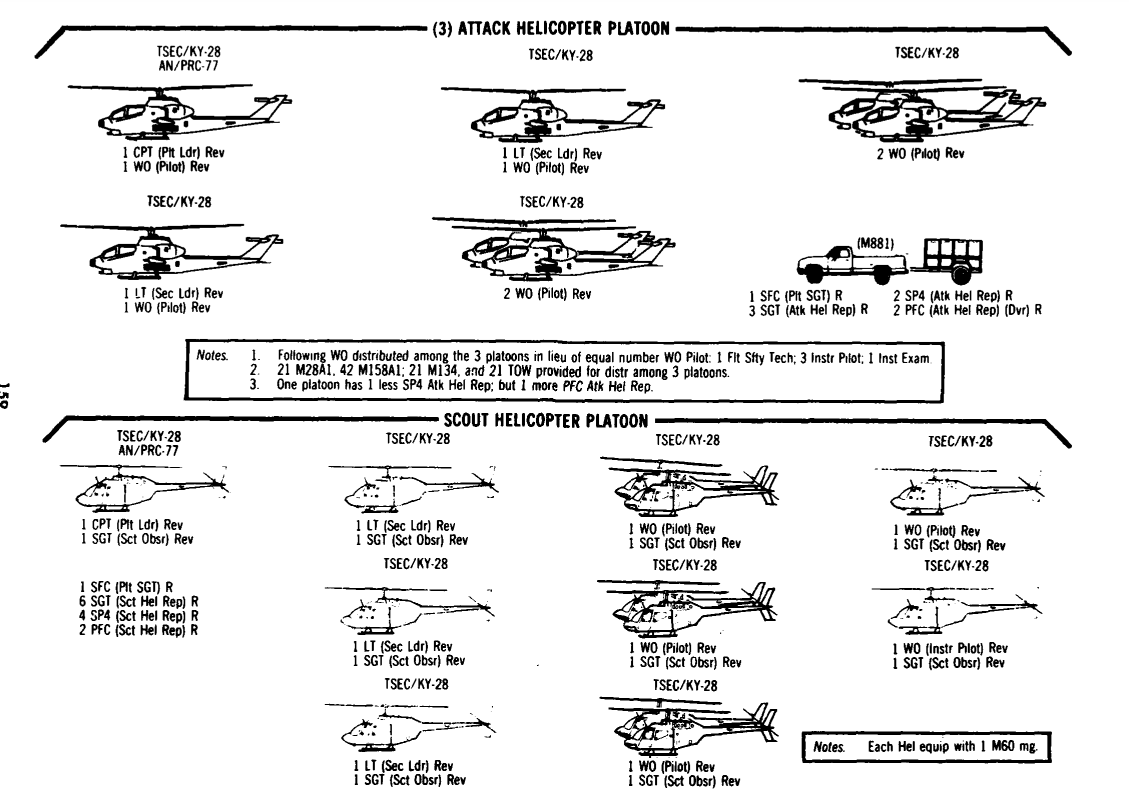1 | The 🇺🇸 U.S. Army Attack Company, an AH-64D/E Apache attack helicopter formation part of Attack Battalions, Combat Aviation Brigade.
This 🧵thread overviews the evolution of U.S. Army Attack Helicopter organization, as it's changed dramatically several times since the 1960s.
This 🧵thread overviews the evolution of U.S. Army Attack Helicopter organization, as it's changed dramatically several times since the 1960s.

2 | Each Combat Aviation Brigade has an Attack Battalion with 3 Attack Companies, HHC, Aviation Maintenance Company and Forward Support Company. The CAB also has an Air Cavalry Squadron which is similar, but with organic RQ-7BV2 Shadows and an emphasis on recon & security 

3 | Since the Longbow Fire Control Radar (FCR) was introduced in the late 1990s, the TOEs I've seen have generally prescribed 3 FCRs per company/troop. In footage you will often find Longbow-equipped Apaches paired with those without. 

4 | As Apaches can be task organized as two-helo Attack Weapons Teams (AWT), I think the allotment of FCRs to specific platoons in the TOEs is largely arbitrary. But mass-formation photos back-up about 9 Longbow radars per battalion/squadron 

5 | The company structure was pretty much the same circa 2010. This is a Modular force TOE, which is when Brigade Combat Teams became the "units of action" and divisions became modular headquarters rather than complete tactical units in their own right 

6 | It was much different in the early 2000s though. This Force XXI TOE shows an Aeroscout Platoon and Attack Platoon, each with 3 Apaches. However, these platoons were administrative and the company commander would task organize elements from each. 

7 | The basic distinction was the Aeroscout Platoon focused on reconnaissance and aerial security tasks, while the Attack Platoon focused on attack. In previous generations the Aeroscouts were actual dedicated OH-58 scout helicopters. 

8 | The 1997 "Force Projection" TOE was the same, but at that time the Aeroscout Platoon had 3 AH-64s and the Attack Platoon had 5. The Attack Platoon was the one templated for the 3 Longbow FCRs at introduction. 

9 | Compare to this 1981 reference data. At that time, an Attack Helicopter Platoon had 7 AH-1S Cobras in 2 sections. The company also had a Scout Platoon of OH-58As, which were also in Air and Armored Cavalry Squadrons. 

10 | Before the mid-2000s Modular force reforms, Armored Cavalry Squadrons had an Air Cavalry Troop. In the 2000s it was all scout helicopters, but in the 80s it was a mix of air and ground scouts and attack helicopters like in Vietnam.








11 | Sidenote, the attack helicopter symbol of the late 70s/80s was tank + aviation. I believe this was due to a AirLand Battle shift towards employing attack helicopters for maneuver rather than just close-in fire support or aerial security like in the 60s/early 70s 

12 | ROAD was the Army of the 60s. AirLand Battle was an overarching doctrine of the 80/90s. The emphasis before AirLand Battle was (1) direct aerial fire to support ground maneuver and (2) aerial security for air assaults, but not attack helicopter maneuver itself 

13 | There was a time in the 1960s when the most centralized attack helicopter-type formation was part of the DIVARTY rather than a divisional Aviation Group (although it was moved to the Aviation Group later).




14 | A closer look at the Aerial Artillery Battery from 1967 reference data. At that time it had 12 UH-1B helicopters, soon to be replaced by the AH-1 Cobra. 

15 | Air Cavalry Troops of the Vietnam era also had attack helicopters (first Hueys with rocket pods, and then Cobras in the late 60s), but mainly to support the reconnaissance and security effort with aerial fire
https://twitter.com/battle_order/status/1528862231714463745?s=20
16 | The emphasizing of "fire and maneuver" in their mission statement, the renaming of "Weapons Platoons" to "Attack Helicopter Platoons", and the integration of scout helicopters into dedicated attack helo companies all happened in late 1970s objective TOEs.




17 | The Heli-Scout combo didn't completely die, though. The Apache replaced the Kiowa as the scout helicopter in Air Cavalry Troops, and they're now paired with RQ-7BV2 Shadow UAVs. This enhances their recon capabilities. I talk about it here: https://t.co/RCEEuRfSw8


Also on Threads: threads.net/@battle.order/…
• • •
Missing some Tweet in this thread? You can try to
force a refresh




























